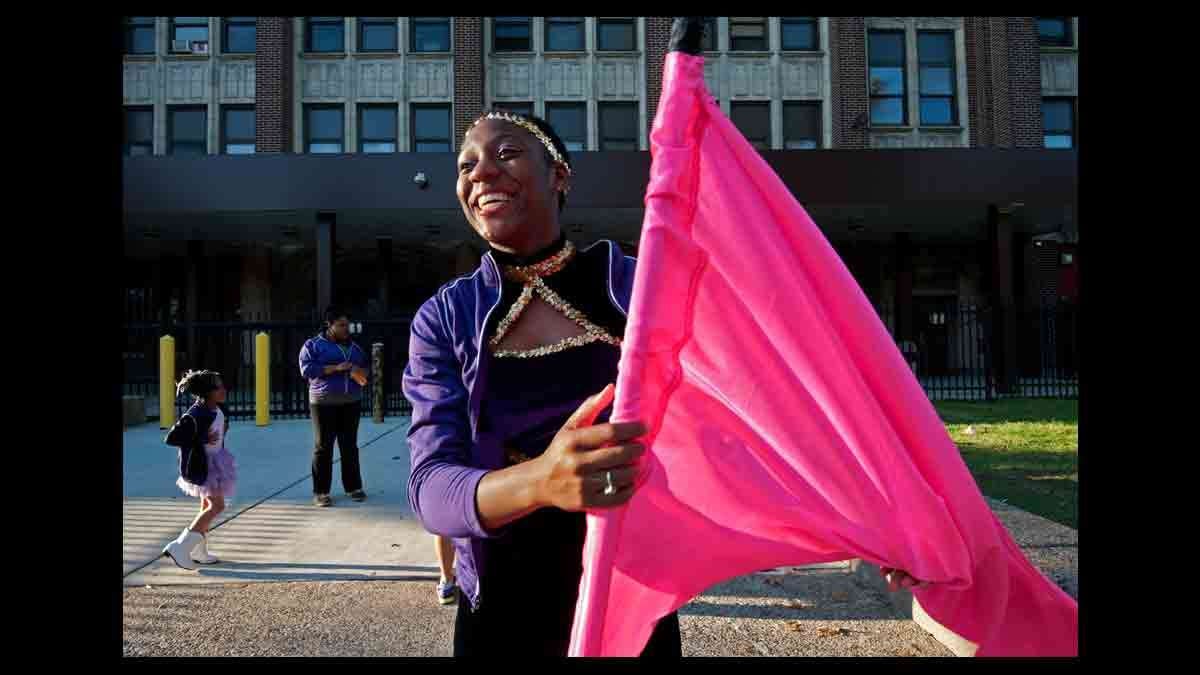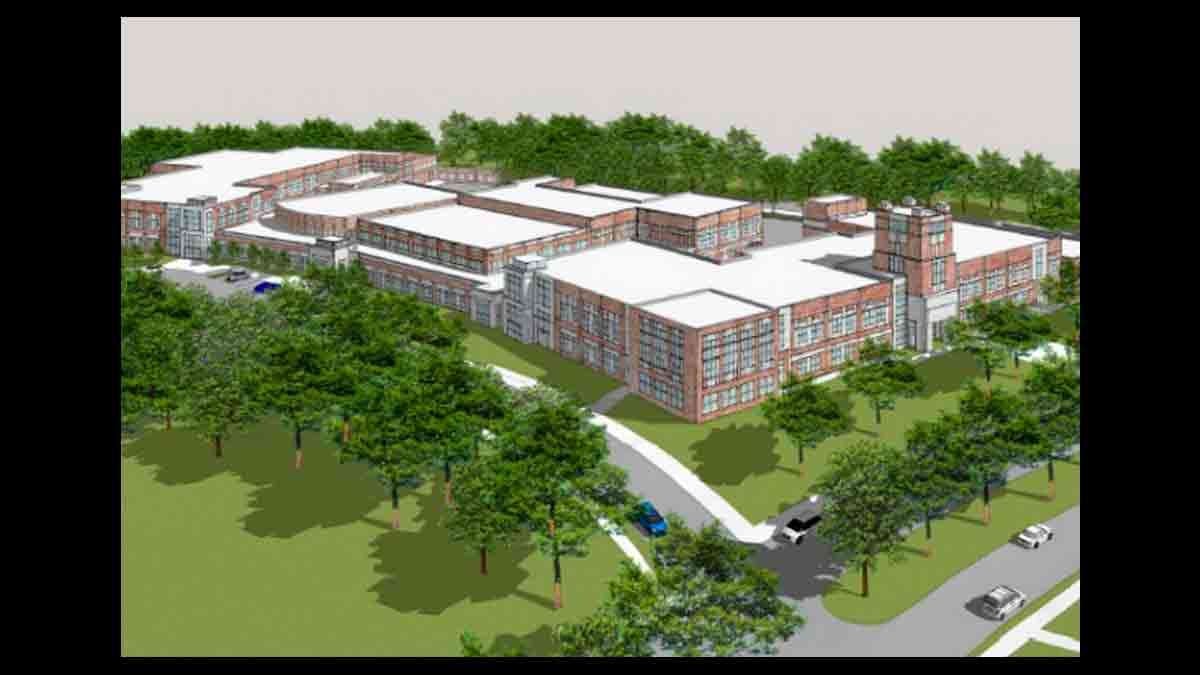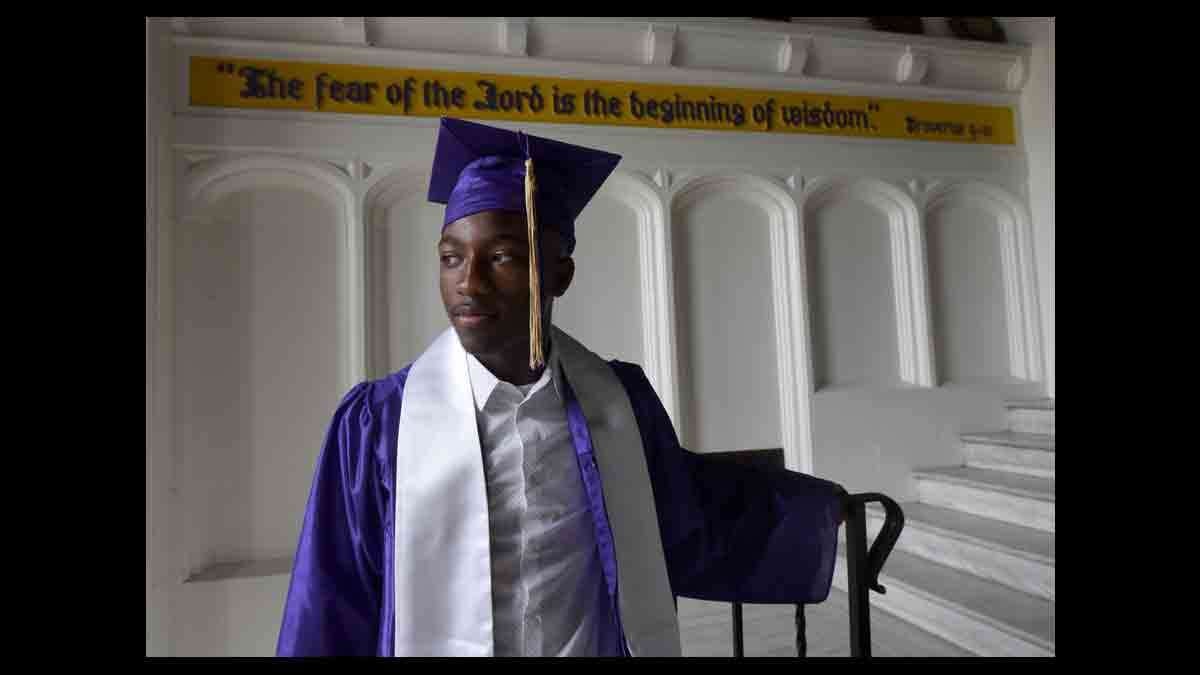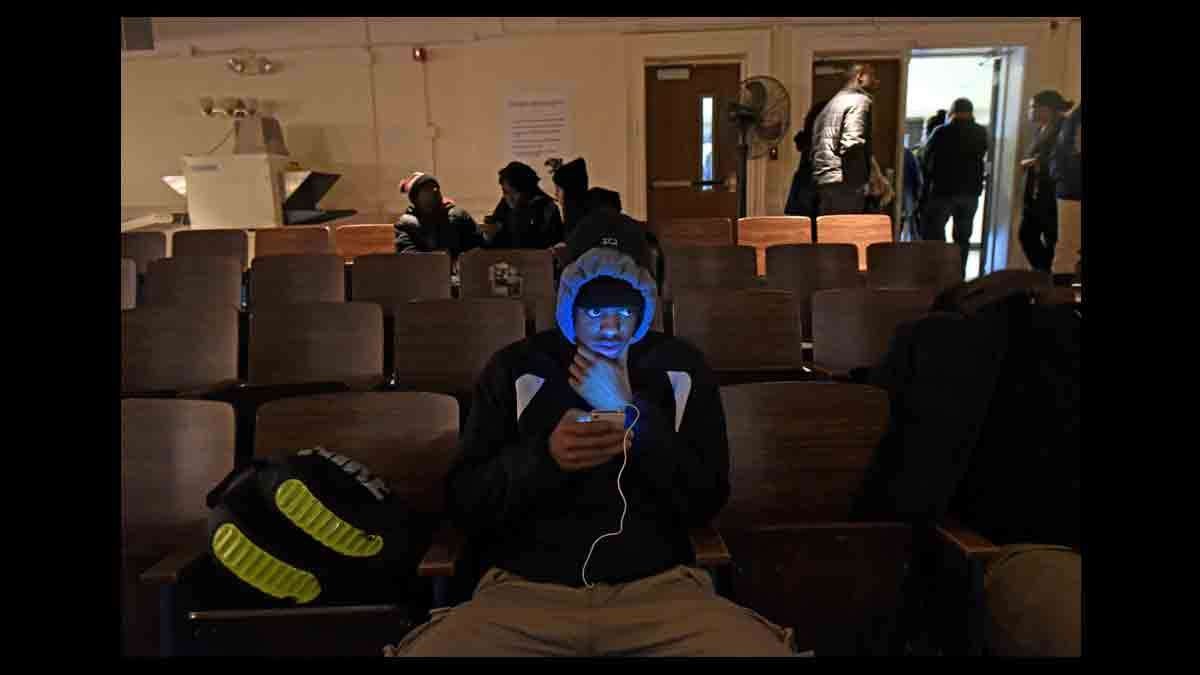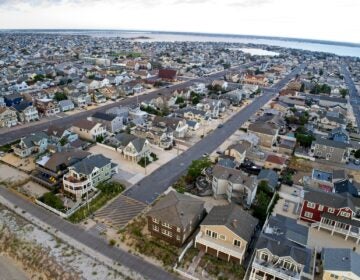A new school for Camden, as a community mourns the old one
For Vida Neil, the planned demolition of Camden High School feels like a death in the family.
At an emotional meeting of the Camden City School District Advisory Board on Tuesday night, Neil was among community members who argued that in spite of a $133 million plan just approved by the New Jersey School Development Authority to level the hundred-year old structure and erect a new set of buildings on the site, the “High’s” regal, 100-year old façade and tower should be preserved.
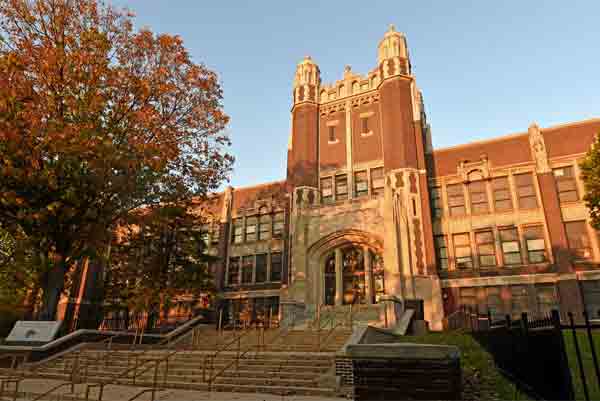 Camden High School (April Saul/for Newsworks)
Camden High School (April Saul/for Newsworks)
An alumnus herself, Neil has lost count of how many relatives attended Camden High; her uncle was a head football coach, her cousin the school secretary for 40 years. “I stand here today representing the purple and the gold for the last person in my family who worked there, which was my mother,” Neil told the board. “She fed every kid, whether they had a lunch ticket or not….We want Camden High revitalized, we want that frontage kept.”
The fight to save “The Castle on the Hill” is about more than historic preservation. Many believe the façade and the spires that stretch to the sky to be the single most powerful symbol of black achievement in this city; especially in recent years, when Camden has ranked among the poorest, most violent cities in America. The icon is a reminder of a time when this flagship school turned out doctors and lawyers, entertainment legends like Leon Huff and world class athletes like Milt Wagner.
For alum Kevin Barfield, losing the original CHS will be a loss. “It would always be something that’s taken out of you…when you pass the school and don’t see that castle on the hill,” he said.
The struggle to decide the fate of Camden High is made even more painful by mistrust and lack of communication–against a backdrop of political pressure and a push for charter schools in this city.
Finally, a new Camden High School?
The plan calls for the replacement of the storied school, known to locals as the “High,” with a 242,000–square-foot building with a campus of four small “school communities.” Two of them would house the academic and vocational sections of the High, with the other two representing magnet schools—Brimm Medical Arts High School and the Big Picture Learning Academy.
In recent years, money had been allocated for improving the High many times. In 2008, then-Governor Jon Corzine, a Democrat, approved $100 million dollars to renovate the school. That plan was shelved when Republican Governor Chris Christie took office and announced a restructuring of the School Development Authority.
Then, in 2014, Christie visited the High and held a press conference to announce the school would be able to receive $50 million of what they’d been promised.
“It was so disingenuous,” says Camden NAACP Vice-President Darnell Hardwick. “Here’s this white guy coming in and pretending to care about inner city people, when the money had already been allocated and he took it away from them.”
This time, the speed at which the current proposal was approved with little communication with the community also upset people.
Eight days after Camden Mayor Dana Redd and Camden Superintendent Paymon Rouhanifard held a meeting to inform a select group of residents about the plan, it was approved by the state’s School Development Authority in Trenton. A few hours after that October 4 meeting and vote—during which concerned residents and alumni gave testimony they hoped might dissuade the SDA from approving the project–Christie appeared at the High for a pre-planned press conference to celebrate.
At the Advisory Board meeting on October 18, Rouhanifard publicly acknowledged that there was “more we could have done” to reach out to the community; earlier that day, the District issued a press release announcing a it would form three community-led committees to drive the project to completion.
Camden High: an ailing, outdated building
Nobody disputes that Camden High is in desperate need of repair. At the SDA hearing, N.J. Assemblyman and CHS graduate Arthur Barclay got choked up as he spoke about the deteriorating condition of the school where he coaches the basketball team. “If it’s too hot, we got to send the kids home; if it’s too cold, we got to send them home,” he said, of the extreme temperature changes that are the result of the building’s circa-1950 boiler. With no functional locker room, his players change in a classroom, and rodents are sighted frequently. Because of lead levels, the tap water at CHS was deemed unsafe to drink over a decade ago.
Wendy Kunz, who directed planning and construction of Camden schools from 2004 to 2013, says the beloved main building “doesn’t accommodate today’s educational philosophies. The classrooms were too small, corridors were too large, the science labs too narrow and long.”
Charter schools, broken promises
In the days since the plan was announced, Rouhanifard has been reassuring wary residents that Camden High will remain “a traditional public school” and not become a charter. Still, he says he is aware of the “broken promises” that make some fear that after four-years of demolition and rebuilding, the new campus may be converted to a charter school in what many see as the rush to privatize education in the city–or that it will never be built at all.
For some, the lack of trust can be summed up in two words: Lanning Square. After the Lanning Square school, named after the first mayor of Camden, was vacated in 2002 and eventually torn down because of fears it might collapse, then Corzine promised a new $42.4 million Lanning Square School, to be opened in August 2010. When Christie became governor, he halted that construction, even though the community had been involved in the plans, the land had been cleared, nearby homes had been seized through eminent domain, and other school projects with lower priority scores had been given the green light.
Instead–in its place—amid much controversy and with an assist from the Urban Hope Act, which helped facilitate easier approval of Renaissance charter schools—the shiny, brick-and-glass KIPP Cooper Norcross Academy was erected and opened last year on the site of the old Lanning public school.
It was a betrayal that still stings, especially for public school advocates—and one they feel can easily be repeated since the state took over their school district in 2013 and the school board became an advisory body with no governing power. “No one trusts a thing,” says Camden High Parent Teacher Organization president and alum Moneke Singleton-Ragsdale, “because we still have an appointed school board.” Theo Spencer, a CHS alum who served on the Camden board from 2007 to 2010, says, “At the point we lost our board of education, we lost the ability to make decisions people would like to make. What do we have to do to get our school district back?”
Debate over preservation
Everyone–including Rouhanifard–agrees that the castle façade of Camden High should be saved if at all possible. But Rouhanifard says it’s just too expensive.
Saving the current CHS “tower” would probably have a price tag of roughly $200 million and not be cost-effective, according to Rouhanifard. “If you did that….you’d be right back at square one, versus a new building that lasts another hundred years,” he said.
That figure is far higher than the $3 million the school board voted to spend refurbishing the tower in 2009—or even the $21 million that they decided not to spend to save the façade that same year.
Theo Spencer agrees with the superintendent. In a conversation with Rouhanifard after a neighborhood meeting in Parkside, Spencer said that when he was a board member and researched preservation, he found that the closest brick mason to do the work lived in London and the bricks cost eight dollars each.
“I’m an alum,” he said. “I been there, I played there. Just destroy it….just start fresh. For what it was going to cost just to keep the tower, you could’ve built an entire school! “You’d have to make sure,” he added, “that the building wasn’t going to crumble as they were renovating it.”
Parkside resident Patricia Rodgers overhears and turns to Spencer as she leaves the meeting. “Ill take that chance!” she exclaims.
“We’re going to pray on it,” she tells him and Rouhanifard, “and save it.”
A forgotten plan
For Wendy Kunz, the former school planner, the issue is not so much trying to save the facade, but whether the new CHS design really serves the community’s needs. The choice is whether to go with the District’s new plan, which she says basically offers “a two-story suburban high school situated on an urban site” or do what she’d envisioned before her School District job was eliminated in 2013—to erect a three-story building at the sidewalk level and incorporate the tower in the design, constructing two-story buildings behind it, thus creating space for playing fields and more parking—and even save the existing gym, where so many Camden legends were made.
More importantly, she had hoped to make CHS into a true community school, with services for residents as well as students–including a health center where Brimm students could also learn medical skills.
“What is lacking in any minority school district is a social and economic safety network,” she said. “Suburban kids don’t worry about where they’re going to sleep at night or having to take care of younger siblings.
“To have 150 million of marvelous facilities open from 8 to 4 and shut down every weekend and summers is a crime.”
The preliminary cost for that plan in 2012, Kunz remembers, was $110 million, which included saving the tower.
“What are you doing to our babies?”
At the Parkside meeting, Rouhanifard promised “a whole host of wonderful amenities” in the new complex, including two gymnasiums, two cafeterias, four locker rooms and a mock trial room. But there were as of yet no plans on a “swing” or temporary location for staff and the students—an omission that many found troubling.
Camden High student Xavier Diaz doesn’t understand why the District didn’t stop enrolling freshmen and then wait until the rest of the students finished their schooling to put the building out of commission for so long.
Diaz points out that should current CHS students decide to transfer next year, the Camden magnet schools demand an audition or letters of recommendation; and that many of the students at CHS have already transferred from charter schools they either didn’t like or that kicked them out. Woodrow Wilson High is an option, but Diaz worries the existing rivalry between Camden High and Wilson will make things “so tense you could cut it with a knife.”
When Camden High senior Ja’Nayzia Morris heard that her school was to be demolished and rebuilt, she cried. She says some of her teachers told her, “It’s selfish of us to want the school to say the same, it’s in such bad condition.” Classmate Diaz can’t stand that the mural the seniors painted every day after school last year in the second floor hallway is “just going to get destroyed.”
Camden High Alumni Association Acting Vice-President Carmen Lozada asks what unveiling the project without a plan for their schooling says to the current CHS students. “You’re scattering our children and tossing them out; what are you doing to our babies?” With many students living in poverty, she says, “One thing that makes them feel good is to have that Camden Panther pride. “For homeless babies, for kids who go from house to house or live in shelters or hotels, this is their home,” says Lozada. “The castle is a safe haven for them.”
_________________________________________
April Saul is a Pulitzer Prize-winning photojournalist who spent the 2014-15 school year embedded at Camden High School and who served as advisor to the Camden High school newspaper, The Castle Crier, during the past year. She writes about Camden on her Facebook page, “Camden, NJ: A Spirit Invincible”
WHYY is your source for fact-based, in-depth journalism and information. As a nonprofit organization, we rely on financial support from readers like you. Please give today.




